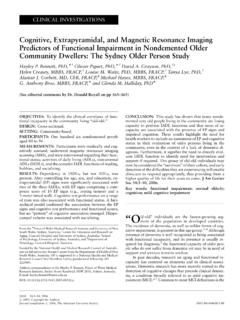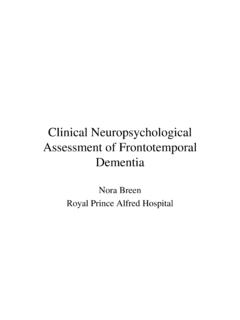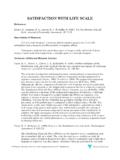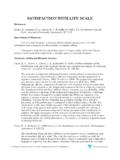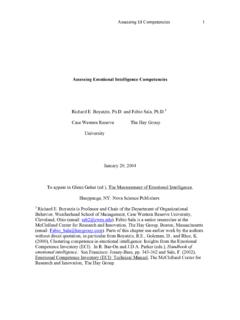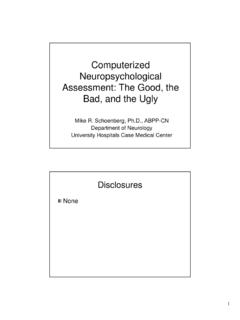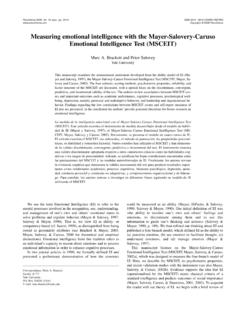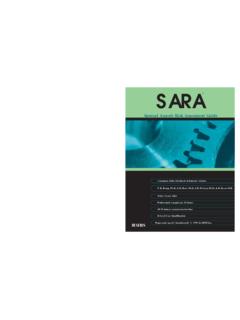Transcription of The Addenbrooke’s Cognitive Examination Revised …
1 The addenbrooke s Cognitive Examination Revised (ACE-R): a brief Cognitive test battery fordementia screeningEneida Mioshi1,2, Kate Dawson2, Joanna Mitchell2, Robert Arnold1and John R. Hodges1,2*1 MRC Cognition and Brain Sciences Unit, Cambridge, UK2 University of Cambridge Department of Clinical Neurosciences, addenbrooke s Hospital, Cambridge, UKSUMMARYT here is a clear need for brief, but sensitive and specific, Cognitive screening instruments as evidenced by the popularity of theAddenbrooke s Cognitive Examination (ACE).ObjectivesWe aimed to validate an improved revision (the ACE-R) which incorporates five sub-domain scores(orientation/attention, memory, verbal fluency, language and visuo-spatial).
2 MethodsStandard tests for evaluating dementia screening tests were applied. A total of 241 subjects participated in thisstudy (Alzheimer s disease 67, frontotemporal dementia 55, dementia of Lewy Bodies 20; mild Cognitive impair-ment MCI 36; controls 63).ResultsReliability of the ACE-R was very good (alpha coefficient ). Correlation with the Clinical Dementia Scalewas significant (r ,p< ). Two cut-offs were defined (88: sensitivity , specificity ; 82:sensitivity , specificity ). Likelihood ratios of dementia were generated for scores between 88 and 82: at acut-off of 82 the likelihood of dementia is 100:1. A comparison of individual age and education matched groups of MCI, ADand controls placed the MCI group performance between controls and AD and revealed MCI patients to be impaired in areasother than memory (attention/orientation, verbal fluency and language).
3 ConclusionsThe ACE-R accomplishes standards of a valid dementia screening test, sensitive to early cognitivedysfunction. Copyright#2006 John Wiley & Sons, words addenbrooke s Cognitive Examination ; dementia; Alzheimer s disease; mild Cognitive impairmentBACKGROUNDThe need for brief, inexpensive and sensitive screen-ing Cognitive tests is widely acknowledged. TheAddenbrooke sCognitiveExamination ACE,(Mathuranathet al., 2000) was developed to providea brief test sensitive to the early stages of dementia,and capable of differentiating subtypes of dementiaincludingAlzheimer sdisease,frontotemporaldementia, progressive supranuclear palsy and otherparkinsonian syndromes (Mathuranathet al.)
4 , 2000;Bieret al., 2004; Baket al., 2005; Dudaset al., 2005;Galtonet al., 2005; Larner, 2005). It has been used inCambridge for over a decade, and has been adopted inseveral international sites on five continents, (Mathur-anathet al., 2004; Sarasolaet al., 2004; Bieret al.,2005; Newman 2005; Garcia-Caballeroet al., 2006).Our extensive clinical and research experience hashighlighted strengths and weaknesses, which has ledus to modify the changes were implemented to make the testeasier to administer. Content modifications were alsomade in order to facilitate cross-cultural usage andtranslation, and also to hopefully increase instance, the naming component of the old ACEsuffered ceiling effects, while the visuospatialcomponent was very limited.
5 Another innovationwas the creation of three different alternativeINTERNATIONAL JOURNAL OF GERIATRIC PSYCHIATRYInt J Geriatr Psychiatry2006;21: 1078 online 15 September 2006 in Wiley InterScience( )DOI: *Correspondence to: Prof. J. R. Hodges, MRC-CBU, 15 ChaucerRoad, Cambridge, CB2 2EF, : John Wiley & Sons, 15 December 2005 Accepted 12 April 2006versions A, B and C, with different stimuli for thename and address recall, in order to prevent recallingfrom previous clinic visits. Finally, the individual26 components were combined to produce fivesub-scores, each one representing a specific cognitivedomain and contributing fairly equally to the first aim in this study was to demonstrate thatthese changes could improve sensitivity and speci-ficity for detecting dementia based upon likelihoodratios that could fill the gap between the two currentlyused cut-off scores.
6 As well as providing more detailednormative data for the ACE-R total score, we aimed toprovide normative sub-scale scores. Given theimportance of early detection in dementia we aimedto define the profile of performance on the ACE-R inpatients with mild Cognitive impairment (MCI).Finally, we aimed to analyse its properties in orderto validate the ACE-R for clinical instrumentThe ACE-R takes between 12 and 20 min (average 16)to administer and score in a clinical setting. It contains5 sub-scores, each one representing one cognitivedomain: attention/orientation (18 points), memory(26 points), fluency (14 points), language (26 points)and visuospatial (16 points).
7 ACE-R maximum scoreis 100, composed by the addition of the all attention/orientation componentswere not modified. In the memory domain severalchanges were made: the name and address test scoringwas modified so that only the final trial contributed tothe sub-score, and a recognition component wasadded. Three versions of the name and address recalland recognition test were designed. Retrogradememory questions were simplified as controls haddifficulty answering previous ones, which were alsonot easily translated. These changes reduced thememory domain weight in the final score, whichallowed other domains to have a more balancedcontribution to the final score.
8 The fluency tests hadtheir scaling scoring Revised . In the language domain,comprehension of commands was removed, newsemantic comprehension questions were added, thepictures for the naming test were changed to reduceceiling effects and reading of regular words wasexcluded. Adding new tasks of perceptual abilities,counting of dot arrays and identification of fragmentedletters augmented the visuospatial domain. Thescoring of the clock face drawing was expanded(0 5) to reflect a better range of changes underwent numerous cycles ofinteractive modification after piloting in variouspatients before the final version of the ACE-R wasgiven to the patients and controls reported total of 241 subjects participated, consisting of threegroups: a dementia group (Alzheimer s disease 67,frontotemporal dementia 55, dementia of LewyBodies 20), a mild Cognitive impairment MCIgroup (n 36) and a control group (n 63).
9 Dementia groupThis group comprised of consecutive patients assessedin one of our three Cognitive clinics at addenbrooke sHospital (Memory Clinic, Early Onset DementiaClinic and Drug monitoring Clinic) between May2004 and March 2005. Subjects were included in thestudy if: (1) they could perform the assessment; (2)had a carer; (3) the Clinical Dementia Rating (Morris,1997) had been completed within 90 days. They wereexcluded if presenting: (1) a significant psychiatricdisorder (depression, schizophrenia); (2) evidence of amixed concomitant dementia processes ( AD andvascular dementia); and (3) causes of cognitiveimpairment other than neurodegenerative disease( epilepsy, head injury, alcoholism).
10 Criteria usedfor selecting patients for the study were similar tothose used for the validation of the first version(Mathuranathet al., 2000). For classifying subgroupsof dementia we used the following criteria: NationalInstitute of Neurological and Communicative Dis-orders and Stroke/Alzheimer s Disease and RelatedDisorders Association NINCDS-ADRDA (McKhannet al., 1984) and the FTD consensus criteria (Nearyet al., 1998). FTD group here comprises the threevariants Frontal variant FTD, Semantic Dementia andProgressive non-fluent Aphasia. Dementia with Lewybodies (DLB) was diagnosed in accordance with theMcKeithet al. criteria (2000).

